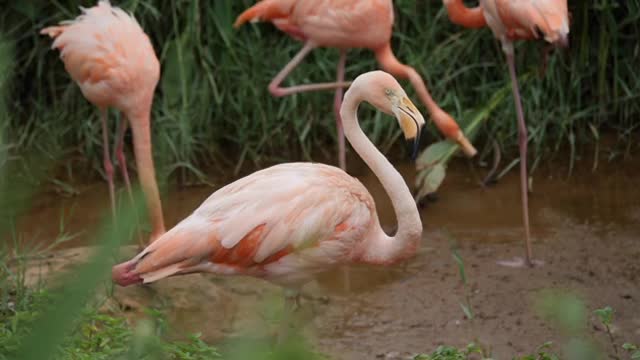Premium Only Content

Pink Flamingo Cleans Out Her Body
Pink Flamingo Cleans Out Her Body , Flamingos are the most instantly recognizable wading birds in the world, but what makes them so special that they capture the hearts of birders and non-birders alike? These fun flamingo facts and trivia may surprise you!
There are only six species of flamingos in the world, though several of those species have subspecies divisions and could eventually be split into different unique species. All flamingos belong to the bird family Phoenicopteridae.
Flamingos are found around the world from the Caribbean and South America to Africa, the Middle East, and Europe. They are also popular guests in many zoos, aviaries, aquariums, marine parks, and botanical gardens well outside their native ranges. Occasional escaped flamingos often make headlines among birders.
The word "flamingo" comes from the Spanish and Latin word "flamenco" which means fire, and refers to the bright color of the birds' feathers. Not all flamingos are brightly colored, however, and some of the birds are mostly gray or white. The strength of a flamingo's coloration comes from its diet. Younger birds also have less coloration.
While flamingos are considered wading birds, the same classification as herons, egrets, spoonbills, and cranes, they are most closely related to grebes genetically.
Flamingos are strong but rare swimmers and powerful fliers, even though they're most often seen just wading. Flamingos do fly very well, however, and many flamingos migrate or regularly fly between the best food sources and nesting grounds.
When flying in a flock, the top speed of a flamingo can be as high as 35 miles per hour (56 kilometers per hour). They can seem ungainly or clumsy in flight, however, because their long necks stretch out in front of their bodies and their long legs dangle well past their short tails, giving them a wobbly appearance.
Flamingos hold their bent bills upside down while feeding, often for several hours a day, so they can filter out their food while skimming the water. They may seem to nibble or scoop at the surface of the water as they strain out small bits of algae, plant material, insects, brine shrimp, and other foods that make up their omnivorous diet.
A flamingo chick's bill is small and straight, without any distinct color patches. After a few months, their growing bills will develop the distinct "break" curve and they will be eating mostly on their own.
Flamingos are monogamous birds that lay only a single egg each year. If that egg is lost, damaged, or other wise does not hatch, they do not typically lay a replacement. If a flamingo colony is ransacked by predators or hit with a natural disaster, it can take several years for the birds to recover and for their population to grow again.
Parent flamingos feed their chicks exclusively crop milk for 5-12 days after hatching. After that time, the chicks do begin to forage on their own, though young flamingos may continue to eat crop milk for up to two months as their bills develop.
This high fat, high protein substance is not like mammalian milk, but is excellent nutrition for growing chicks. Parent flamingos produce crop milk in their digestive tracts and regurgitate it to feed their young.
Flamingo chicks are born gray or white and take up to three years to reach their mature pink, orange, or red plumage. Their young feathers are much less structured and fluffier than adult plumage, but that down provides excellent insulation to help keep baby flamingos warm.
-
 1:45
1:45
WGBA
2 years agoPink Flamingo
4 -
 1:46
1:46
WGBA
2 years agoPink Flamingo weekend brings community together for
5 -
 1:12
1:12
Lvasil
3 years agoPink flamingo
22 -
 6:21
6:21
The Kansas Flamingo Chef
2 years agoMake a Pink Flamingo Cake
16 -
 1:03:45
1:03:45
Donald Trump Jr.
8 hours agoHappy Festivus: Airing Our Grievances and Stopping The Swamp w/Sean Davis | TRIGGERED Ep.201
134K187 -
 1:58:10
1:58:10
Robert Gouveia
6 hours agoMatt Gaetz REJECTS Report, Sues Committee; Luigi Fan Club Arrives; Biden Commutes; Festivus Waste
61.9K66 -
 58:10
58:10
Kimberly Guilfoyle
8 hours agoAmerica is Back & The Future is Bright: A Year in Review | Ep. 183
52.1K50 -
 3:03:27
3:03:27
vivafrei
13 hours agoEp. 242: Barnes is BACK AGAIN! Trump, Fani, J6, RFK, Chip Roy, USS Liberty AND MORE! Viva & Barnes
100K54 -
 8:09:50
8:09:50
Dr Disrespect
11 hours ago🔴LIVE - DR DISRESPECT - MARVEL RIVALS - GOLD VANGUARD
175K30 -
 1:15:00
1:15:00
Awaken With JP
10 hours agoMerry Christmas NOT Happy Holidays! Special - LIES Ep 71
150K115